engine VOLVO XC70 2004 Workshop Manual
[x] Cancel search | Manufacturer: VOLVO, Model Year: 2004, Model line: XC70, Model: VOLVO XC70 2004Pages: 241, PDF Size: 5.78 MB
Page 177 of 241

2004 VOLVO XC70
recommends use of oil with a quality rating equal to or higher than ILSA\
C GF-2. Equivalent and better
oils include ACEA A1, API SJ, SJ/CF, and SJ/Energy conserving. Lower qua\
lity oils may not offer the
same fuel economy, engine performance, or engine protection.
Volvo Cars recommends Castrol.
Depending on your driving habits, premium or synthetic oils may provide \
superior fuel economy and
engine protection. Consult your Volvo retailer for recommendations on pr\
emium or synthetic oils.
Oil additives must not be used.
NOTE: Synthetic oil is not used when the oil is changed at the normal mainten\
ance services. This oil is
only used at customer request, at additional charge. Please consult your\
Volvo retailer.
Oil viscosity (stable ambient temperatures)
Oil viscosity (stable ambient temperatures)
Operation in temperate climates
Incorrect viscosity oil can shorten engine life. Under normal use when t\
emperatures do not exceed 86 °F
(30°C), SAE 5W/30 will provide good fuel economy and engine protect\
ion. See the viscosity chart
below.
Operation in hot climates
When temperatures exceed 86 °F (30°C) in your area, Volvo recomm\
ends, for the protection of your
engine, that you use a heavier weight oil, such as SAE 10W/30. See the v\
iscosity chart below.
Extreme engine operation
Synthetic oils meeting SAE 10W/30 and complying with oil quality require\
ments are recommended for
driving in areas of sustained temperature extremes (hot or cold), when\
towing a trailer over long
distances, and for prolonged driving in mountainous areas.
Changing oil and oil filter
Oil and oil filter changes should be made at 7,500 mile (12,000 km) in\
tervals.
The API Service Symbol
file:///K|/ownersdocs/2004/2004_XC70/04xc70_08b.htm (8 of 16)12/30/200\
6 4:33:06 PM
Page 178 of 241

2004 VOLVO XC70
The API Service Symbol "donut" is divided into three parts:
l The top half describes the oil's performance level.
l The center identifies the oil's viscosity.
l The bottom half tells whether the oil has demonstrated energy-conserving\
proper ties in a standard
test in comparison to a reference oil.
Viscosity (stable ambient temperatures)
Break-in Period
Although some oil consumption occurs during normal engine operation, mor\
e oil is consumed when the
engine is new as the internal parts generate higher friction while weari\
ng-in each other. From the time
the engine is new until the first service is performed, the oil consumpt\
ion could be higher than
normal. For this reason, it is especially important to check the oil eve\
ry time you refuel you car
during this period.
pg. 138 Engine oil
Checking the oil level
The oil level should be checked every time the car is refueled. This is \
especially important during
the period up to the first service.
CAUTION:
Not checking the oil level regularly can result in serious engine damage\
if the oil level becomes too low.
file:///K|/ownersdocs/2004/2004_XC70/04xc70_08b.htm (9 of 16)12/30/200\
6 4:33:06 PM
Page 179 of 241
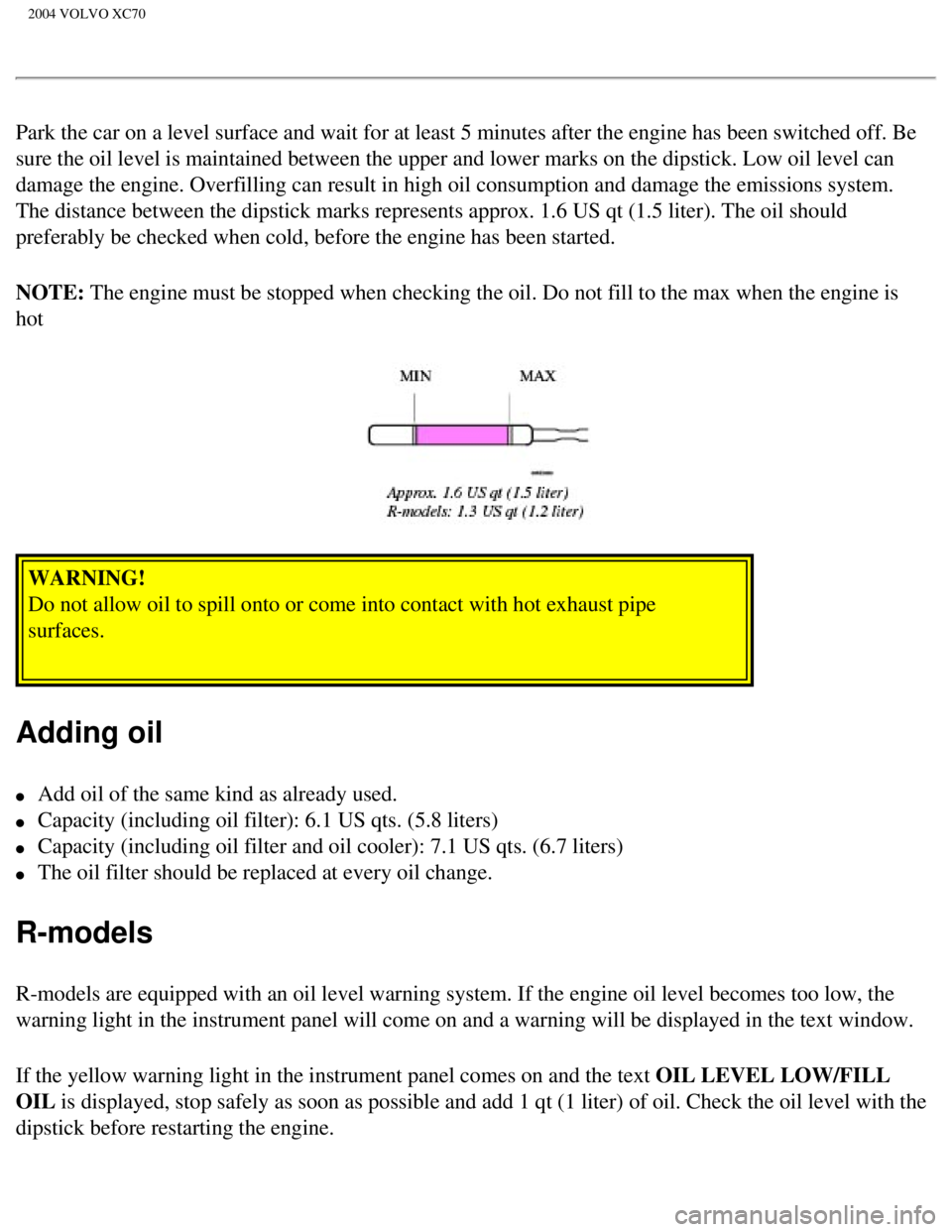
2004 VOLVO XC70
Park the car on a level surface and wait for at least 5 minutes after th\
e engine has been switched off. Be
sure the oil level is maintained between the upper and lower marks on th\
e dipstick. Low oil level can
damage the engine. Overfilling can result in high oil consumption and da\
mage the emissions system.
The distance between the dipstick marks represents approx. 1.6 US qt (1\
.5 liter). The oil should
preferably be checked when cold, before the engine has been started.
NOTE: The engine must be stopped when checking the oil. Do not fill to the max\
when the engine is
hot
WARNING!
Do not allow oil to spill onto or come into contact with hot exhaust pip\
e
surfaces.
Adding oil
l Add oil of the same kind as already used.
l Capacity (including oil filter): 6.1 US qts. (5.8 liters)
l Capacity (including oil filter and oil cooler): 7.1 US qts. (6.7 lite\
rs)
l The oil filter should be replaced at every oil change.
R-models
R-models are equipped with an oil level warning system. If the engine oi\
l level becomes too low, the
warning light in the instrument panel will come on and a warning will be\
displayed in the text window.
If the yellow warning light in the instrument panel comes on and the tex\
t OIL LEVEL LOW/FILL
OIL is displayed, stop safely as soon as possible and add 1 qt (1 liter) o\
f oil. Check the oil level with the
dipstick before restarting the engine.
file:///K|/ownersdocs/2004/2004_XC70/04xc70_08b.htm (10 of 16)12/30/20\
06 4:33:06 PM
Page 180 of 241
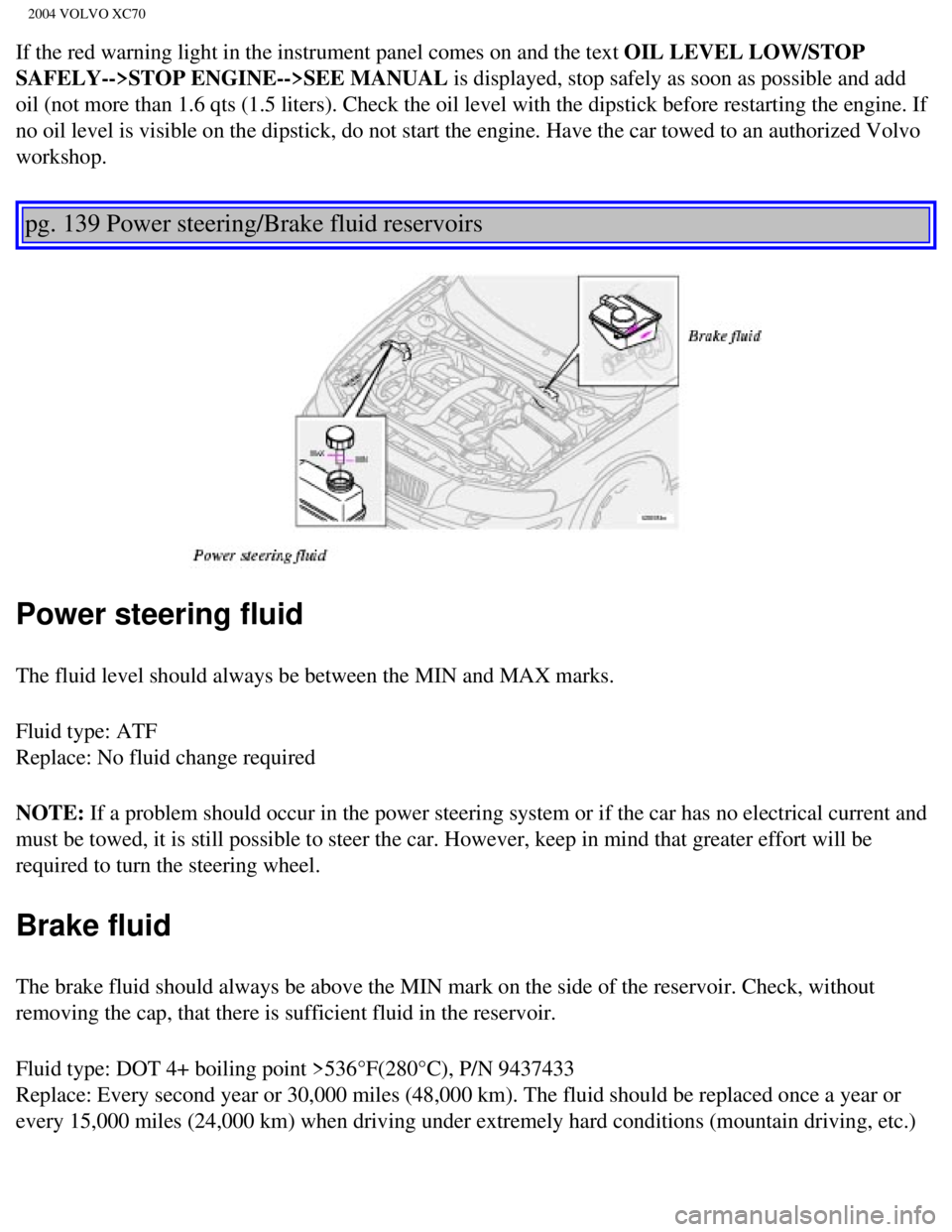
2004 VOLVO XC70
If the red warning light in the instrument panel comes on and the text OIL LEVEL LOW/STOP
SAFELY-->STOP ENGINE-->SEE MANUAL is displayed, stop safely as soon as possible and add
oil (not more than 1.6 qts (1.5 liters). Check the oil level with the\
dipstick before restarting the engine. If
no oil level is visible on the dipstick, do not start the engine. Have t\
he car towed to an authorized Volvo
workshop.
pg. 139 Power steering/Brake fluid reservoirs
Power steering fluid
The fluid level should always be between the MIN and MAX marks.
Fluid type: ATF
Replace: No fluid change required
NOTE: If a problem should occur in the power steering system or if the car ha\
s no electrical current and
must be towed, it is still possible to steer the car. However, keep in m\
ind that greater effort will be
required to turn the steering wheel.
Brake fluid
The brake fluid should always be above the MIN mark on the side of the r\
eservoir. Check, without
removing the cap, that there is sufficient fluid in the reservoir.
Fluid type: DOT 4+ boiling point >536°F(280°C), P/N 9437433
Replace: Every second year or 30,000 miles (48,000 km). The fluid shou\
ld be replaced once a year or
every 15,000 miles (24,000 km) when driving under extremely hard condi\
tions (mountain driving, etc.)
file:///K|/ownersdocs/2004/2004_XC70/04xc70_08b.htm (11 of 16)12/30/20\
06 4:33:06 PM
Page 181 of 241

2004 VOLVO XC70
Always entrust brake fluid changing to an authorized Volvo retailer.
pg. 140 Battery maintenance
Battery maintenance
The battery in your car is located under the floor of the cargo area.
Driving habits and conditions, climate, the number of starts, etc. all a\
ffect the service life and function of
the battery. In order for your battery to perform satisfactorily, keep t\
he following in mind:
l Check the fluid level in each cell in the battery every 24 months or eve\
ry 15,000* miles (24,000 km),
whichever is sooner. The fluid should be at the level shown in the illus\
tration above (A**).
Use a screwdriver to open the caps and a flashlight to inspect the level\
.
l If necessary, add distilled water. The level should never be above the indicator (A).
l The fluid level should be checked if the battery has been recharged.
l After inspection, be sure the cap over each battery cell is securely in \
place.
l Check that the battery cables are correctly connected and properly tight\
ened.
l Never disconnect the battery when the engine is running, for example whe\
n changing the battery.
l The battery should be disconnected from the vehicle when a battery charg\
er is used directly on the
battery. However, if the battery is being charged via the connecting poi\
nts in the engine compartment
(see
page 104), the battery must be connected.
PROPOSITION 65 WARNING!
Battery posts, terminals, and related accessories contain lead and lead \
compounds, chemicals known
to the state of California to cause cancer and reproductive harm. Wash h\
ands after handling.
file:///K|/ownersdocs/2004/2004_XC70/04xc70_08b.htm (12 of 16)12/30/20\
06 4:33:06 PM
Page 186 of 241
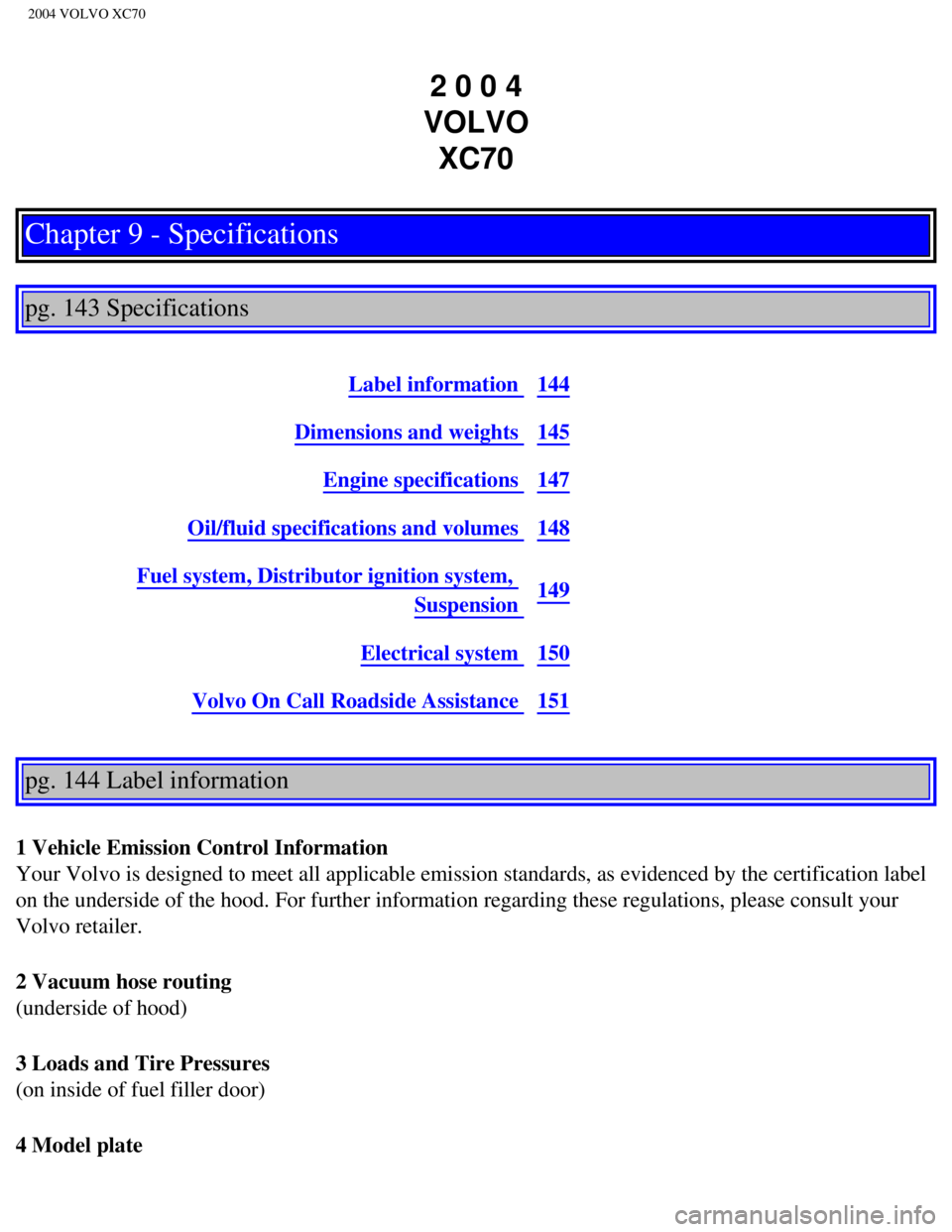
2004 VOLVO XC70
2 0 0 4
VOLVO XC70
Chapter 9 - Specifications
pg. 143 Specifications
Label information 144
Dimensions and weights 145
Engine specifications 147
Oil/fluid specifications and volumes 148
Fuel system, Distributor ignition system,
Suspension 149
Electrical system 150
Volvo On Call Roadside Assistance 151
pg. 144 Label information
1 Vehicle Emission Control Information
Your Volvo is designed to meet all applicable emission standards, as evi\
denced by the certification label
on the underside of the hood. For further information regarding these re\
gulations, please consult your
Volvo retailer.
2 Vacuum hose routing
(underside of hood)
3 Loads and Tire Pressures
(on inside of fuel filler door)
4 Model plate
file:///K|/ownersdocs/2004/2004_XC70/04xc70_09.htm (1 of 12)12/30/2006\
4:33:07 PM
Page 187 of 241

2004 VOLVO XC70
Vehicle Identification Number (VIN). Codes for color and upholstery, e\
tc. The plate is located in the
engine compartment, on the inside of the left front fender.
5 Vehicle Identification Number (VIN) *
The VIN plate is located on the top left surface of the dashboard. The V\
IN is also stamped on the right
hand door pillar.
6 Federal Motor Vehicle Safety Standards (FMVSS) specifications (USA)\
and Ministry of
Transport (CMVSS) standards (Canada)
Your Volvo is designed to meet all applicable safety standards, as evide\
nced by the certification label on
the facing side of the driver's door. For further information regarding \
these regulations, please consult
your Volvo retailer.
7 Child safety latch label
* The Vehicle Identification Number (VIN) should always be quoted in a\
ll correspondence concerning
your vehicle with the retailer and when ordering parts.
All specifications are subject to change without prior notice.
file:///K|/ownersdocs/2004/2004_XC70/04xc70_09.htm (2 of 12)12/30/2006\
4:33:07 PM
Page 190 of 241

2004 VOLVO XC70
V70, V70 Turbo 2470 lbs 1120 kg
V70 AWD 2580 lbs 1170 kg
V70 AWD-R 2580 lbs 1170 kg
XC70 2620 lbs 1190 kg
* The max permissible axle loads or the gross vehicle weight must not be\
exceeded.
pg. 147 Engine specifications
Engine specifications
Designation: Volvo B 5234 T3
Output 247 hp at 5200 rpm (184 kW/87 rps)
Max. torque 243 ft. lbs. at 2400-5200 rpm (330 Nm/42-87
rps)
Number of
cylinders 5
Bore 3.19" (81 mm)
Stroke 3.54" (90 mm)
Displacement 2.3 liters
Compression ratio 8.5:1
Number of valves 20
Designation: Volvo B 5254 T2
Output 208 hp at 5000 rpm (154 kW/83 rps)
Max. torque 236 ft. lbs. at 1500-4500 rpm (320 Nm/25-75
rps)
Number of
cylinders 5
Bore 3.27" (83 mm)
Stroke 3.67" (93.2 mm)
Displacement 2.5 liters
Compression ratio 9.0:1
Number of valves 20
file:///K|/ownersdocs/2004/2004_XC70/04xc70_09.htm (5 of 12)12/30/2006\
4:33:07 PM
Page 192 of 241
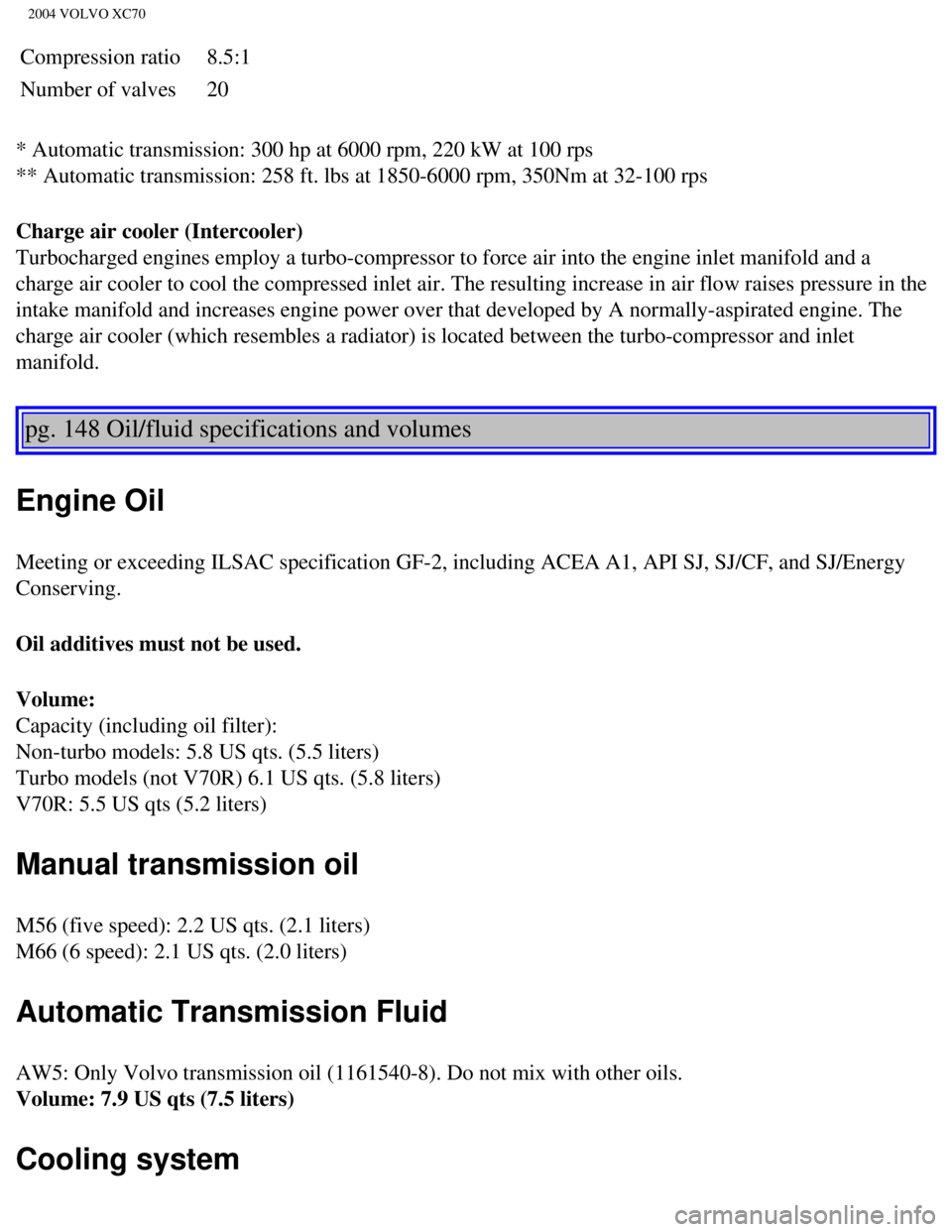
2004 VOLVO XC70
Compression ratio 8.5:1
Number of valves 20
* Automatic transmission: 300 hp at 6000 rpm, 220 kW at 100 rps
** Automatic transmission: 258 ft. lbs at 1850-6000 rpm, 350Nm at 32-100\
rps
Charge air cooler (Intercooler)
Turbocharged engines employ a turbo-compressor to force air into the eng\
ine inlet manifold and a
charge air cooler to cool the compressed inlet air. The resulting increa\
se in air flow raises pressure in the
intake manifold and increases engine power over that developed by A norm\
ally-aspirated engine. The
charge air cooler (which resembles a radiator) is located between the \
turbo-compressor and inlet
manifold.
pg. 148 Oil/fluid specifications and volumes
Engine Oil
Meeting or exceeding ILSAC specification GF-2, including ACEA A1, API SJ\
, SJ/CF, and SJ/Energy
Conserving.
Oil additives must not be used.
Volume:
Capacity (including oil filter):
Non-turbo models: 5.8 US qts. (5.5 liters)
Turbo models (not V70R) 6.1 US qts. (5.8 liters)
V70R: 5.5 US qts (5.2 liters)
Manual transmission oil
M56 (five speed): 2.2 US qts. (2.1 liters)
M66 (6 speed): 2.1 US qts. (2.0 liters)
Automatic Transmission Fluid
AW5: Only Volvo transmission oil (1161540-8). Do not mix with other oi\
ls.
Volume: 7.9 US qts (7.5 liters)
Cooling system
file:///K|/ownersdocs/2004/2004_XC70/04xc70_09.htm (7 of 12)12/30/2006\
4:33:07 PM
Page 194 of 241
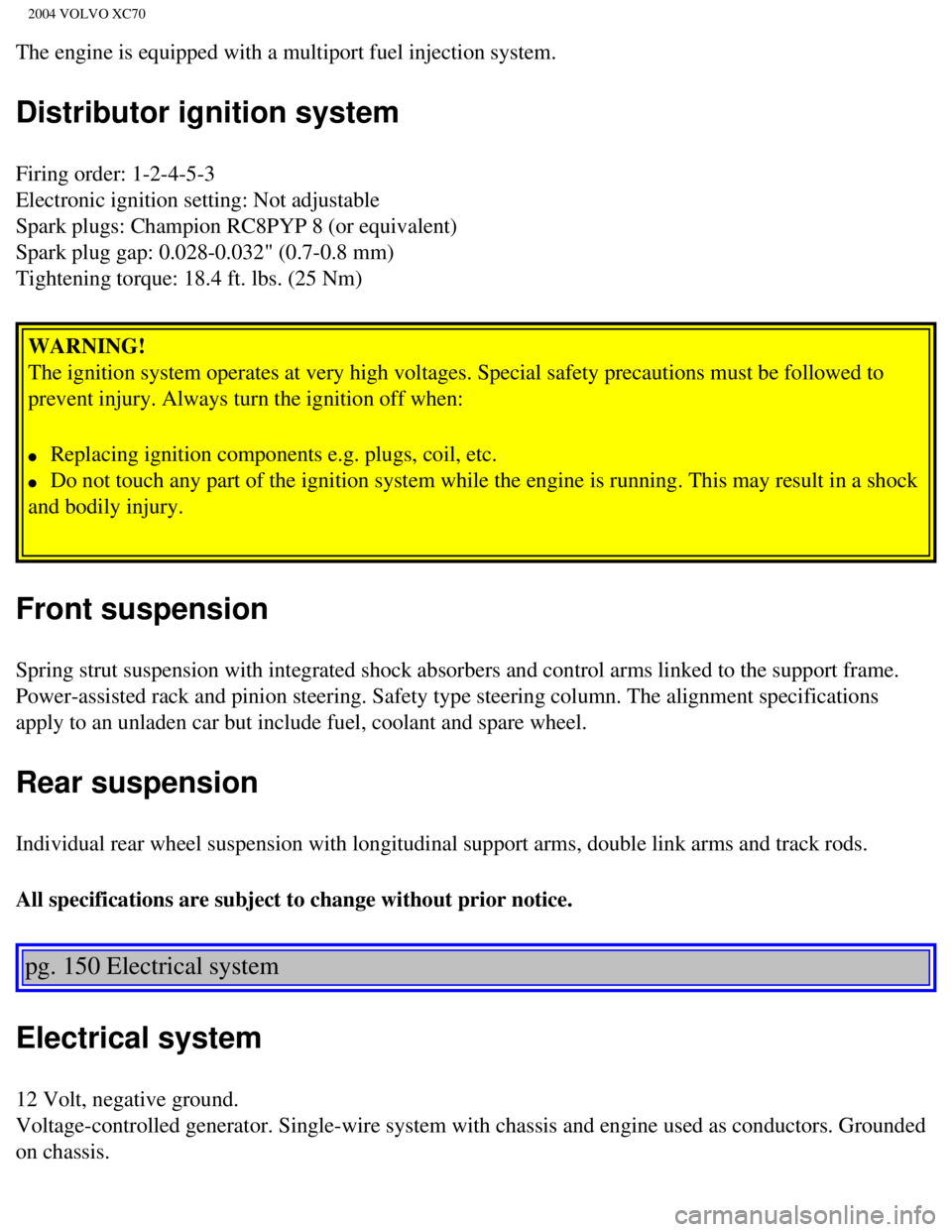
2004 VOLVO XC70
The engine is equipped with a multiport fuel injection system.
Distributor ignition system
Firing order: 1-2-4-5-3
Electronic ignition setting: Not adjustable
Spark plugs: Champion RC8PYP 8 (or equivalent)
Spark plug gap: 0.028-0.032" (0.7-0.8 mm)
Tightening torque: 18.4 ft. lbs. (25 Nm) WARNING!
The ignition system operates at very high voltages. Special safety preca\
utions must be followed to
prevent injury. Always turn the ignition off when:
l Replacing ignition components e.g. plugs, coil, etc.
l Do not touch any part of the ignition system while the engine is running\
. This may result in a shock
and bodily injury.
Front suspension
Spring strut suspension with integrated shock absorbers and control arms\
linked to the support frame.
Power-assisted rack and pinion steering. Safety type steering column. Th\
e alignment specifications
apply to an unladen car but include fuel, coolant and spare wheel.
Rear suspension
Individual rear wheel suspension with longitudinal support arms, double \
link arms and track rods.
All specifications are subject to change without prior notice.
pg. 150 Electrical system
Electrical system
12 Volt, negative ground.
Voltage-controlled generator. Single-wire system with chassis and engine\
used as conductors. Grounded
on chassis.
file:///K|/ownersdocs/2004/2004_XC70/04xc70_09.htm (9 of 12)12/30/2006\
4:33:07 PM